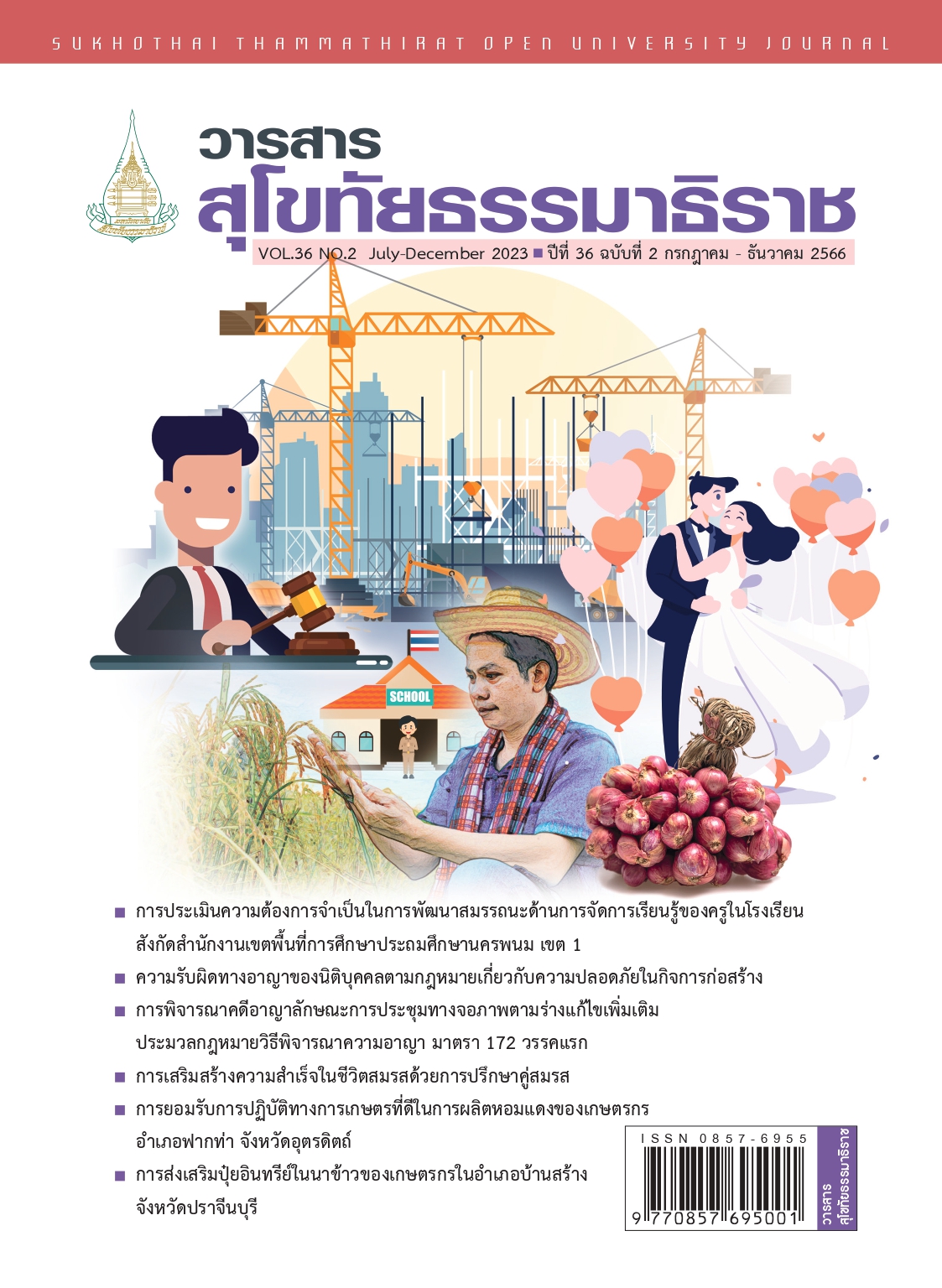การยอมรับการปฏิบัติทางการเกษตรที่ดีของการผลิตหอมแดงของเกษตรกร ในพื้นที่อำเภอฟากท่า จังหวัดอุตรดิตถ์
คำสำคัญ:
การปฏิบัติทางการเกษตรที่ดี, การผลิตหอมแดง , การส่งเสริมการผลิตหอมแดงบทคัดย่อ
การวิจัยนี้มีวัตถุประสงค์เพื่อศึกษา (1) สภาพสังคม เศรษฐกิจและการผลิตหอมแดงของเกษตรกร (2) การยอมรับการผลิตหอมแดงตามการปฏิบัติทางการเกษตรที่ดีของเกษตรกร (3) ปัญหาและข้อเสนอแนะเกี่ยวกับการยอมรับการผลิตหอมแดงตามการปฏิบัติทางการเกษตรที่ดีของเกษตรกร ประชากรที่ศึกษา คือ เกษตรกรผู้ปลูกหอมแดงในอำเภอฟากท่า จังหวัดอุตรดิตถ์ ที่ขึ้นทะเบียนเกษตรกรปี 2564-2565 จำนวน 137 ราย ใช้สูตร ท่าโร่ ยามาเน่ ในการกำหนดกลุ่มตัวอย่างที่ระดับความเชื่อมั่น 0.05 ได้กลุ่มตัวอย่างจำนวน 120 ราย โดยใช้การสุ่มอย่างง่าย เครื่องมือที่ใช้เก็บข้อมูลในงานวิจัย คือ แบบสัมภาษณ์และวิเคราะห์ข้อมูลทางสถิติโดยการหาค่าความถี่ ค่าเฉลี่ย ค่าร้อยละ ค่าสูงสุด ค่าต่ำสุด ค่าเบี่ยงเบนมาตรฐานและการจัดลำดับ
ผลการวิจัยพบว่า 1) เกษตรกรส่วนใหญ่เป็นเพศชาย อายุเฉลี่ย 53.23 ปี มีประสบการณ์ปลูกหอมแดงเฉลี่ย 23.52 ปี เข้าร่วมการอบรมการผลิตหอมแดงตามการปฏิบัติทางการเกษตรที่ดี เฉลี่ย 1 ครั้ง/ปี มีพื้นที่ปลูกเฉลี่ย 5.49 ไร่ มีรายได้เฉลี่ย 268,833.33 บาท/ปี มีต้นทุนเฉลี่ย 116,983.33 บาท/ปี เกษตรกรใช้หัวพันธุ์ที่เก็บเองและขายผลผลิตให้พ่อค้าคนกลาง 2) เกษตรกรยอมรับการผลิตหอมแดงตามมาตรฐานการปฏิบัติทางการเกษตรที่ดีในระดับมาก (เฉลี่ย 3.68) ได้แก่ มีการจัดการก่อนและหลังการเก็บเกี่ยวที่เหมาะสม ใช้วัตถุอันตรายทางการเกษตรอย่างปลอดภัย ใช้หัวพันธุ์หอมแดงที่ปลอดโรค พื้นที่เพาะปลูกเหมาะสม มีการบันทึกข้อมูลและมีการใช้น้ำจากแหล่งน้ำที่ปลอดภัย 3) เกษตรกรประสบปัญหาถูกกดราคาจากพ่อค้าคนกลางและปัญหาราคาขายของหอมแดงที่ได้รับการรับรองมาตรฐานไม่แตกต่างกับหอมแดงทั่วไป โดยมีข้อเสนอแนะให้หน่วยงานที่เกี่ยวข้องควรบูรณาการร่วมกันแก้ไขปัญหา เจ้าหน้าที่ควรพัฒนาทักษะและความรู้ที่เกี่ยวกับการปฏิบัติทางการเกษตรที่ดีให้แก่เกษตรกรให้มากขึ้น
เอกสารอ้างอิง
Atchariya Bunyawantang and Kobchai Woraphimpong. 2018. Acceptance of sweet corn production according to the system. Good Agriculture Appropriate (GAP) of farmers in Thai Phae District, Satun Province. Department of Development Agriculture, Faculty of Natural Resources Prince of Songkla University.
Grassroots Economic Development Group Trade Strengthening Policy Division Office of Policy andTrade strategy. 2022. Analysis of the Thai economic and trade situation by region: Northern Region: Uttaradit Province joins with the Ministry of Commerce to help farmers who raise shallots. Data source: http://www.tpso.moc.go.th/th. Retrieved 20 March 2023.
Kangsadan Kanokhong, Narubet Rattanawan and Paphob Jirat. 2019. Adoption of plant cultivation methods under standards of good agricultural practices (GAP) of farmers, Mon Ngo Royal Project Development Center, Mae Taeng District Chiang Mai Province. Research and promote agriculture.36, (1), 75-84.
Kanokporn Nanthadee, Putsan Krueakham, Apichana Wongwaratecha, Paphob Jirat and Teerthawat Purintharaphiban. 2019. Agricultural Production Journal 1(3): 49-60: Study of demand for academic services in Agriculture of farmers in San Sai District Chiang Mai Province Faculty of Agricultural Production Maejo University Chiang Mai Province.
Nampueng Tha Khlong. 2021. Existence and changes in shallot production under the concept of geography. Agriculture: Case study of Ban Yang Chum Yai, Village No. 1, Yang Chum Noi District Sisaket Province. Academic Social Science Journal 14(2): 95-109.
Nuanphit Meedecha, Putthi Sankhruekham, Phahon Sakkatat and Kangsadan Kanokhong. 2019. Perception of agricultural development under the Thailand 4.0 policy of farmers in Sop Peng Subdistrict, Mae Taeng District, Chiang Mai Province. Journal of Agricultural Research and Extension 37(3): 60-70.
Office of Agricultural Economics. 2022. Area for growing shallots in 2022. Online system. Data source:https://www.oae.go.th/view/1/Table showing shallot details/TH-TH Retrieved 10 July 2023.
Patcharin Suphan, Patcharee Inthanu and Kongnaren Jaikampan. 2020. Factors affecting the adoption of standards. Certified according to Good Agricultural Production (GAP) in the upper northern region of Thailand. Maejo University Chiang Mai Province. Journal of Agricultural Research and Promotion 38(3): 152-170.
Phongsak Onmoy and Peeraya Ungudornpakdee. 2016. Health and behavioral impact assessment. Self-protection from the use of chemical pesticides among shallot farmers, Chai Jumpol Subdistrict, Laplae District, Uttaradit Province. Journal of Community Development and Quality of Life 4(3): 416-428.
Sanguansak Srisutham. 2017. Shallot. Edible knowledge box. Online system, data source: https://www.okmd.or.th/upload/pdf/2560/KC/Shallot.pdf Retrieved June 17, 2023.
Uttaradit Provincial Agriculture Office. 2022. Provincial agricultural development plan 2018 – 2022. Review edition, year 2022. Uttaradit.
Wanasanan Rungchai, Phongsathorn Chayasawasat, Kasem Penalawat, Wiwatwongbunnun, Kanklao Phonken, lecturer of Faculty of Business Administration and Accountancy, Sisaket Rajabhat University. 2019. Analysis of costs and returns from growing shallots. In the area of Yang Chum Noi District Sisaket Province. Sisaket Rajabhat University. Academic journal 13(3): 118-123.
Waraporn Chomngam, Phatthana Sukprasert, Siros Thongchuea, Natthaphon Detphumi. 2021. Factors related to complying with Good Agricultural Practices (GAP) standards of parsley farmers in Nakhon Sawan Province: Narathiwat Rajanagarindra University Journal 13(2), 354-317.
ดาวน์โหลด
เผยแพร่แล้ว
รูปแบบการอ้างอิง
ฉบับ
ประเภทบทความ
สัญญาอนุญาต
ลิขสิทธิ์ (c) 2024 มหาวิทยาลัยสุโขทัยธรรมาธิราช

อนุญาตภายใต้เงื่อนไข Creative Commons Attribution-NonCommercial-NoDerivatives 4.0 International License.
บทความที่ได้รับการตีพิมพ์เป็นลิขสิทธิ์ของวารสารมหาวิทยาลัยสุโขทัยธรรมาธิราช
ข้อความที่ปรากฏในบทความแต่ละเรื่องในวารสารวิชาการเล่มนี้เป็นความคิดเห็นส่วนตัวของผู้เขียนแต่ละท่านไม่เกี่ยวข้องกับมหาวิทยาลัยสุโขทัยธรรมาธิราช และคณาจารย์ท่านอื่นๆในมหาวิทยาลัยฯ แต่อย่างใด ความรับผิดชอบองค์ประกอบทั้งหมดของบทความแต่ละเรื่องเป็นของผู้เขียนแต่ละท่าน หากมีความผิดพลาดใดๆ ผู้เขียนแต่ละท่านจะรับผิดชอบบทความของตนเองแต่ผู้เดียว
ห้ามนำข้อความทั้งหมด หรือบางส่วนไปพิมพ์ซ้ำ เว้นแต่จะได้รับอนุญาตจากกองบรรณาธิการวารสาร



